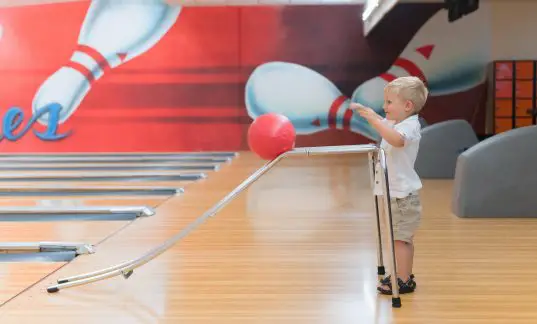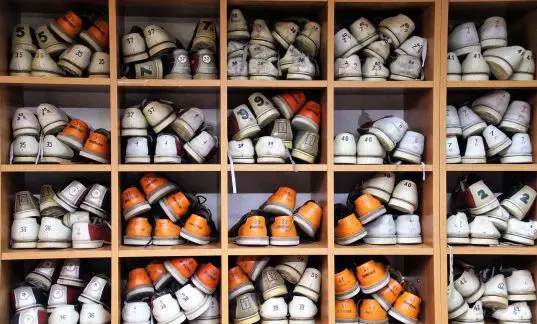Are you one of those bowlers who has been there and done that? Does one frame bleed into the next frame and leave you wanting more? Whether you’re an intermediate player trying to improve your game or an expert bowler with high hopes of professional success, you’ll inevitably want to change things up a bit at some point.
If you’re interested in taking things up a notch in your day-to-day bowling exploits, Scotch Doubles match play might be the way to go!
But, first — how do two teammates play together in a game of bowling?
How Do You Play Doubles In Bowling?
In traditional doubles bowling, two bowlers play together with two scorecards for an entire game. The scores for both games are tallied together as one score. If it’s a head-to-head doubles match, the best team score wins. In traditional doubles bowling tournaments, the best average score of the best doubles team wins out.
Regular doubles bowling is a whole lot of fun. However, what if both bowlers on a team bowled in a first frame together? And what if they played as one player would, rather than as a team of two?
Welcome to the world of Scotch Doubles bowling.
What Is Scotch Doubles In Bowling?
In a Scotch Doubles game of bowling, two players play together on the same scorecard and alternate every single shot. That’s right. No matter what happens throughout a game, the two players on a Scotch Doubles team are required to bowl one shot and then hand off the next shot to their teammate.
Let’s say you shoot a seven on the first shot of the first frame. Your teammate would be responsible for picking up the spare. If you throw a strike, your teammate gets a fresh frame to go for their own. If they can’t match you, you’ll have to pick up their spare.
Scoring in Scotch Doubles bowling goes by normal ten-pin bowling rules. Nothing changes, except that two players compete together for the highest single score. Generally, this changes everything about how you play a game of bowling. If the player responsible for the first shots simply isn’t able to throw strikes, you’ll be stuck converting spares all game long. If one person isn’t able to hack it, the other bowler is relegated to a janitorial role of sorts.
During Scotch Doubles tournaments, a night can end up being a lot of fun or a lot of stress. If one player is missing pins left and right and leaving splits behind them all the time, the other player might get a little resentful. Conversely, pushing each other for strike after strike leads to a sense of camaraderie that’s simply unmatched in the sport of bowling.
To achieve the latter rather than suffering the former, we’ve compiled a handful of Scotch Doubles tips for you to employ before your next tournament.
A Few Strategies To Succeed In A Scotch Doubles Tournament At Your Local Bowling Center
1) Find a teammate to alternate shots throughout with who pushes you to play your best.
To determine which player you want to play a Scotch Doubles tournament with, look at more than just their bowling score averages and their handicap. Find another player that wants to win (and have fun) just as badly as you do. When you throw a ball, your partner should be there to cheer you on and congratulate you when you do well. When you struggle, your partner’s presence and skill should pick you up and make you want to do better.
2) Team up with a player who shoots with the opposite dominant hand.
How many times have you left a corner pin up on what felt like a ringing strike shot? If you’re a left-handed bowler, the 7 pin is likely your mortal enemy. If you’re a right-handed bowler, the 10 pin probably haunts your dream. A Scotch Doubles bowling team with opposite dominant hands can balance this out, giving the spare shooter a chance to pick up corner pins in the corner opposite of their dominant hand. This isn’t talked about a lot on bowling websites, but it’s a neat insider’s tip for those who love the Scotch Doubles bowling format.
3) Communicate about lane oil patterns as you trade shots throughout the game.
As the frames progress in Scotch Doubles bowling tournaments, lane oil patterns are bound to break down and change. And if you play Scotch Doubles at multiple sites, this gradual change might be different from bowling alley to bowling alley. Talk with your partner about how your ball is reacting on a given shot, or watch your partner’s throws for evidence of oil irregularities and shifts in density. You can work together to adjust your shots, change your approaches, and put together the best game plan to make oil conditions work to your advantage as a team.
4) Play with someone familiar with most bowling formats.
An experienced bowler is usually a great teammate. They can help you notice problems in your game for quick correction, talk you through crises of confidence, and support you in a way that beginners and intermediate players may not be able to. Also, playing with a partner who’s familiar with bowling in all of its facets gives you a leg up against less-experienced competition. The more you play, the more tools you have in your bowling tool kid. Look for a partner that’s played a lot!
5) Look for a teammate with a comparable skill level or a better player who can push your game to new heights.
Don’t settle on the first Scotch Doubles bowling partner you can find. Look for a player that has complementary bowling skills and that can put together strikes and marks at a similar rate. Or, find a player who might have things together a bit more and use their example and tutelage to grow as a bowler. Look at Scotch Doubles bowling as a way to get better and to help your partner get better. You’ll be much better off if you do.
6) Be careful about handicaps so you’re not stuck shooting spares all tournaments long.
If you’re playing in a Scotch Doubles tournament that allows handicaps, be careful of playing with players who have large handicaps to their credit. While the score boost might seem tantalizing, the likelihood that you’ll be relegated to picking up their spares in each frame is much higher. That may throw you off your game and nullify any real scoring advantage the handicaps might provide.
Frequently Asked Questions
What is considered a foul in bowling?
A foul occurs in a bowling game when a player’s foot or body touches the foul line, or another part of their body hits part of the building or lane equipment during an approach. If you hit the line or a part of the surrounding alley during a shot, your throw is null and void and your score is registered as zero for that throw. If pins are knocked down on that shot, they will be reset as if nothing had occurred.
Why is it a turkey in bowling?
When a bowler rolls three consecutive strikes in a bowling game, it’s called a turkey. While it seems like an odd name offhand, it has some historical meaning. In the 18th and 19th Centuries, bowling alley operators in the United States regularly held holiday tournaments during the lead-up to Thanksgiving. When a bowler rolled three strikes in a row, they were given a live turkey as a prize. No knock on giving out cash prizes, but that’s a unique way of doing things. And, the name “turkey” has stuck ever since then.


